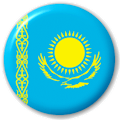Kyrgyzstan and Tajikistan 2018
Kyrgyzstan and Tajikistan 2018

Kazakhstan 2018
I know the heading to today’s diary states ‘Almaty to Kurchatov’, but that is actually a little ambitious. I am typing this on a train that is moving, mostly slowly, across the featureless steppes to the east of Astana towards Kurchatov, a journey of 800 kilometres that is taking about 15 hours (3:45pm to 6:45am).
We set off this morning at 9:00am to travel about 30 kilometres west of Astana to the small town of Akmol. Akmol celebrates (if that is the right word) Astana’s origins as a gulag for the wives of men who had been declared to be traitors during the period of Stalin’s leadership of the USSR. On the edge of Akmol is the chilling Museum of the Camp for Wives of Traitors to the Motherland, our destination.
To get to the windowless museum, visitors are encouraged to make their approach through a tall arch, known as the Arch of Sorrows, with heads bowed as a way to show respect to the victims of the gulag. To the left of the arch, there are recreated features such as a watchtower and a railway carriage, but once inside the museum, the display is somewhat more sterile. Although there are a few dioramas and a central display featuring a black rose sprouting upwards through a smashed block of granite, most of the display comprises old photographs and copies of documents.
The women who were sent to the gulag were undoubtedly loyal, as going to such a place could often be avoided with a divorce and a public denunciation. There were some interesting stories told during our visit. For example, we learned that in this area of severe water shortages, a lake appeared right beside the gulag, seemingly by magic, shortly after the camp opened. The lake remained before disappearing shortly after the Museum opened.
Another story told how when they arrived in Akmol, the women were sometimes attacked by local people who threw white stones at them as they walked across the snow. One day, one of the women fell and hit her face against a stone, but to her surprise the stone didn’t hurt her, but crumbled. The stones were in fact salted cheese, and the locals were in fact providing food for the inmates under the guise of attacking them.
Returning to Astana, we were taken to what was purported to be a typical Kazakh home to see how a typical family lives. In fact, the house may have been typical but its décor was anything but typical. The house was owned by a family of master craftsmen and artists, and every room was filled with their work, and an assorted range of bric-a-brac and memorabilia that was for sale. It was not a good sign when the door was closed and locked behind us after we had entered. The better news was that the family also provided lunch for us, a delicious meal of salads, dried fruits and cheeses, together with a mix of horse cheek sausages and horse leg meat on pasta.
We left the home at 2:15pm and took the short drive to Astana’s new railway station that was opened last year to catch our 3:45 train to Kurchatov. The train was an old Soviet model with four-berth cabins, certainly adequate for the journey although it could have done with a good coat of paint. There’s not really much to describe so far in terms of scenery – endless flat grass plains under constantly grey overcast skies.
Yerlan had arranged with some friends of his to prepare dinners for us, which were delivered onto the train at one of the station stops at abut 9:30pm. It was a welcome break to enjoy the stuffed peppers with salads and bread before settling down on the hard beds for a not-always-gently rocking sleep for the night.

Day 10
Astana to Kurchatov
Friday
21 September 2018


















